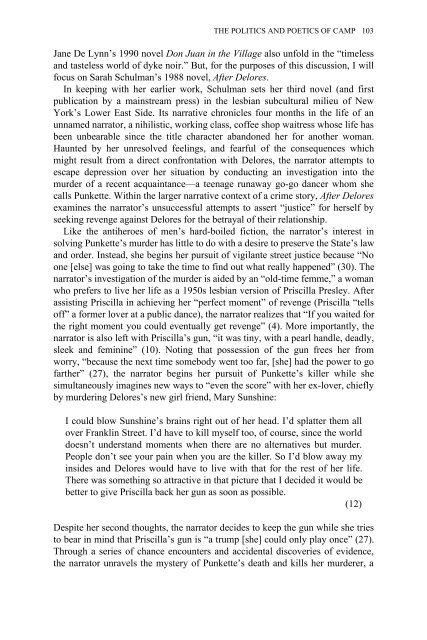Edited by Moe Meyer - Get a Free Blog
Edited by Moe Meyer - Get a Free Blog
Edited by Moe Meyer - Get a Free Blog
You also want an ePaper? Increase the reach of your titles
YUMPU automatically turns print PDFs into web optimized ePapers that Google loves.
THE POLITICS AND POETICS OF CAMP 103<br />
Jane De Lynn’s 1990 novel Don Juan in the Village also unfold in the “timeless<br />
and tasteless world of dyke noir.” But, for the purposes of this discussion, I will<br />
focus on Sarah Schulman’s 1988 novel, After Delores.<br />
In keeping with her earlier work, Schulman sets her third novel (and first<br />
publication <strong>by</strong> a mainstream press) in the lesbian subcultural milieu of New<br />
York’s Lower East Side. Its narrative chronicles four months in the life of an<br />
unnamed narrator, a nihilistic, working class, coffee shop waitress whose life has<br />
been unbearable since the title character abandoned her for another woman.<br />
Haunted <strong>by</strong> her unresolved feelings, and fearful of the consequences which<br />
might result from a direct confrontation with Delores, the narrator attempts to<br />
escape depression over her situation <strong>by</strong> conducting an investigation into the<br />
murder of a recent acquaintance—a teenage runaway go-go dancer whom she<br />
calls Punkette. Within the larger narrative context of a crime story, After Delores<br />
examines the narrator’s unsuccessful attempts to assert “justice” for herself <strong>by</strong><br />
seeking revenge against Delores for the betrayal of their relationship.<br />
Like the antiheroes of men’s hard-boiled fiction, the narrator’s interest in<br />
solving Punkette’s murder has little to do with a desire to preserve the State’s law<br />
and order. Instead, she begins her pursuit of vigilante street justice because “No<br />
one [else] was going to take the time to find out what really happened” (30). The<br />
narrator’s investigation of the murder is aided <strong>by</strong> an “old-time femme,” a woman<br />
who prefers to live her life as a 1950s lesbian version of Priscilla Presley. After<br />
assisting Priscilla in achieving her “perfect moment” of revenge (Priscilla “tells<br />
off” a former lover at a public dance), the narrator realizes that “If you waited for<br />
the right moment you could eventually get revenge” (4). More importantly, the<br />
narrator is also left with Priscilla’s gun, “it was tiny, with a pearl handle, deadly,<br />
sleek and feminine” (10). Noting that possession of the gun frees her from<br />
worry, “because the next time somebody went too far, [she] had the power to go<br />
farther” (27), the narrator begins her pursuit of Punkette’s killer while she<br />
simultaneously imagines new ways to “even the score” with her ex-lover, chiefly<br />
<strong>by</strong> murdering Delores’s new girl friend, Mary Sunshine:<br />
I could blow Sunshine’s brains right out of her head. I’d splatter them all<br />
over Franklin Street. I’d have to kill myself too, of course, since the world<br />
doesn’t understand moments when there are no alternatives but murder.<br />
People don’t see your pain when you are the killer. So I’d blow away my<br />
insides and Delores would have to live with that for the rest of her life.<br />
There was something so attractive in that picture that I decided it would be<br />
better to give Priscilla back her gun as soon as possible.<br />
(12)<br />
Despite her second thoughts, the narrator decides to keep the gun while she tries<br />
to bear in mind that Priscilla’s gun is “a trump [she] could only play once” (27).<br />
Through a series of chance encounters and accidental discoveries of evidence,<br />
the narrator unravels the mystery of Punkette’s death and kills her murderer, a


